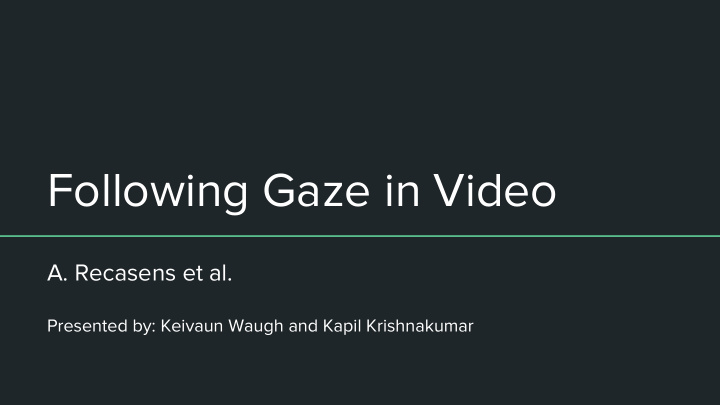



Following Gaze in Video A. Recasens et al. Presented by: Keivaun Waugh and Kapil Krishnakumar
Background ● Given face in one frame, how can we figure out where that person is looking? Target object might not be in the same frame ●
Sample Results Input Video Gaze Density Gazed Area
Architecture
VideoGaze Dataset ● 160k annotations of video frames from MoviesQA dataset ● Annotations: ○ Source Frame Head Location ○ ○ Body Target Frame ( 5 per source frame) ○ ■ Gaze Location Time difference between Source and ■ Target
Experiments ● Naive network architecture Don’t segment network into different into different pathways ○ ○ Concatenate all inputs and predict directly Replace transformation pathway with SIFT+RANSAC affine fit finding ● ● Various neighboring frame prediction windows ● Examine failure cases ○ “Look cone” doesn’t take into account the eye position ○ Other failures
Naive Model
Naive Architecture ● Use fusion of target frame and source frame to predict gaze location Alex Net Source Frame 0 …………… 0 0, 0.4, 0.3, 0 0 ………….. 0 Target Frame 0 ………….. 0 20x20
Alternate Transformation Pathway
Architecture ● Replace deep CNN pathway with traditional SIFT+RANSAC affine warp SIFT + RANSAC
Quantitative Results
Results AUC (higher KL Divergence (lower L2 Dist (lower Description better) better) better) 73.7 8.048 0.225 Normal model with transformation pathway 60.2 6.604 0.294 Normal model with sparse affine 60.2 6.6604 0.294 Normal model with dense affine 60.9 6.641 0.242 Naive model 56.9 28.39 0.437 Random
Qualitative Results
Results ● Input video is 150 frames long Full Video Cropped Head What I’m looking at
Results - Search 150 Neighboring Frames Original Transformation Pathway Naive Model
Results - Search 150 Neighboring Frames Sparse SIFT Affine Warp Dense SIFT Affine Warp
Results - Search 25 Neighboring Frames Original Transformation Pathway Naive Model
Results - Search 25 Neighboring Frames Sparse SIFT Affine Warp Dense SIFT Affine Warp
Target in Same Frame Original Video Original Transformation Pathway Naive Model
Target in Same Frame Sparse SIFT Affine Warp Dense SIFT Affine Warp
Runtimes ● GTX 1070 and Haswell Core i5 Generating results is CPU bound ● ● 5 second video with 150 frame search width ○ Deep transformation pathway: 6.5 minutes Sparse affine: 10.5 minutes ○ ○ Dense affine: 32 minutes 100% CPU Usage GPU Usage 0% Usage when running model with transformation pathway
Failure Cases Input Video Original Transformation Pathway
Failure Cases Input Video Original Transformation Pathway
Conclusions ● Separating input modalities for Saliency and Head Pose provides significant information to the model. ○ Illustrates importance of hand-crafted architecture even though features are automatically discovered ● Head Direction != Eye Direction ● Frame Predictor window selection determines whether match can be found or not.
Recommend
More recommend